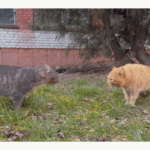Understanding Feline Behavior: When Your Cat Prefers Proximity Over Petting
In the world of feline companionship, our beloved cats often exhibit behaviors that can sometimes be a bit perplexing to us humans. One such behavior is when your cat enjoys being close to you but doesn’t necessarily want to be touched. As cat owners, it’s essential to understand these preferences and respect our feline friends’ boundaries. In this article, we’ll delve into the intriguing world of cats and explore why some cats prefer proximity over petting.
The Curious Nature of Cats
Cats Are Independent Beings
Cats are renowned for their independent nature. Unlike dogs, who often crave physical affection, cats have a unique way of expressing their affection and seeking comfort. This distinct behavior is rooted in their evolutionary history.
Sensory Overload
Cats have highly sensitive sensory organs, including their whiskers, ears, and tails. Sometimes, petting can be overwhelming for them, causing sensory overload. Understanding their limits is crucial to a harmonious human-feline relationship.
The Comfort of Closeness
While some cats may not enjoy being touched, they still relish being near their owners. This closeness provides them with a sense of security and companionship.
Why Cats Prefer Proximity Over Petting
Trust and Safety
Cats are selective about who they trust and feel safe around. When a cat chooses to be near you, it’s a sign of trust. However, not all cats are comfortable with physical contact.
Personal Space
Just like humans, cats have their personal space preferences. While some cats may tolerate petting, others may prefer to maintain a certain distance to protect their personal bubble.
Previous Trauma or Negative Experiences
Cats that have had negative experiences or trauma in the past may be more hesitant about physical contact. Understanding their history is essential for providing the right environment for them.


Respecting Your Cat’s Wishes
Observing Body Language
To understand your cat’s preferences, pay attention to their body language. Purring, relaxed tail positioning, and slow blinking are signs of contentment, while hissing or flattening of ears may indicate discomfort.
Creating a Safe Haven
Ensure your home provides a safe space for your cat. This can include cozy hiding spots and elevated perches where they can observe their surroundings without feeling threatened.
Offering Alternatives
If your cat prefers proximity but not petting, consider interactive toys and gentle play sessions as alternative ways to bond.
Understanding and Nurturing Your Cat’s Unique Personality
Cat Personality Types
Cats have diverse personalities, just like humans. Some are naturally more sociable and affectionate, while others tend to be more reserved. Understanding your cat’s personality can shed light on their preferences.
Socialization and Early Experiences
A cat’s early socialization and experiences during kittenhood can greatly influence their attitude towards human interaction. Cats that were well-socialized as kittens tend to be more receptive to petting.
The Role of Breed
Certain cat breeds, such as the Maine Coon or Ragdoll, are known for their affectionate nature and love for physical contact. However, even within these breeds, individual preferences can vary.
You Can Check Cats Behaviors
Enhancing Your Bond with Your Cat
Patience and Respect
Respecting your cat’s boundaries is key to building a strong bond. If your cat prefers proximity over petting, don’t push them into physical contact. Instead, let them come to you when they’re ready.
Communication through Grooming
Cats often groom themselves as a form of self-comfort. If your cat enjoys being near you, offer them gentle strokes with your hand or a soft brush. This mimics their natural grooming behavior and can be a bonding experience.
Building Trust Over Time
Trust is the foundation of any healthy relationship with your cat. Spend quality time together, engage in interactive play, and offer treats as rewards for positive behavior. Over time, your cat may become more receptive to petting.


Conclusion
In summary, your cat’s preference for proximity over petting is a part of their unique personality. It’s essential to recognize and respect their boundaries, as forcing physical contact can lead to stress and anxiety for your feline companion. By creating a safe and comfortable environment and understanding their cues, you can nurture a loving and fulfilling relationship with your cat.
FAQs
1. Is it common for cats to prefer proximity over petting?
- Yes, many cats have individual preferences, and some prefer being near their owners without physical contact.
2. How can I tell if my cat is comfortable with petting or not?
- Watch for signs of contentment, such as purring and relaxed body language. If your cat shows discomfort, it’s best to refrain from petting.
3. Can I train my cat to enjoy petting if they don’t like it?
- While you can desensitize your cat to touch to some extent, it’s essential to respect their boundaries and not force physical contact.
4. What should I do if my cat has had a traumatic experience in the past?
- Provide a safe and secure environment, be patient, and consult with a veterinarian or animal behaviorist if necessary.
5. Are there specific breeds that are more likely to prefer proximity over petting?
- While individual temperament plays a significant role, certain breeds like the Siamese are known for their love of human companionship but may have their unique preferences regarding petting.
6. My cat used to enjoy petting but has recently become more aloof. What could be the reason?
- Changes in behavior can be due to various factors, including health issues or changes in the household. Consult with a veterinarian if you’re concerned about your cat’s behavior.
7. Are there any specific areas where cats prefer to be petted, if they enjoy it?
- Many cats enjoy gentle strokes along their back, chin, and behind the ears. However, it varies from cat to cat, so pay attention to their reactions.
8. Can I socialize a shy or fearful cat to enjoy petting and human contact?
- Yes, with patience and gradual exposure, shy cats can become more comfortable with human interaction. Consult with an animal behaviorist for guidance.
9. How can I make my home more cat-friendly for a cat that prefers proximity?
- Provide cozy spots for them to perch, soft blankets, and interactive toys. Creating a calm and inviting environment will help your cat feel at ease.
10. Is it possible for a cat’s preference for petting to change over time?
- Yes, a cat’s preferences can evolve. Pay attention to their cues and adjust your interactions accordingly to ensure their comfort and happiness.





